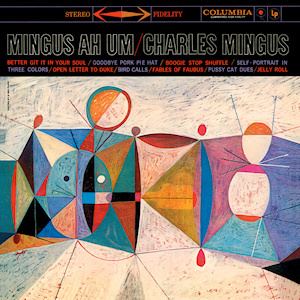Recorded May 5 and May 12, 1959 Label Columbia Awards Grammy Hall of Fame | Length 72:11 Release date 1959 | |
 | ||
Released September 14, 1959 (1959-09-14) Similar Charles Mingus albums, Jazz albums | ||
Charles mingus mingus ah um 1959 full album
Mingus Ah Um is a studio album by American jazz musician Charles Mingus, released in 1959 by Columbia Records. It was his first album recorded for Columbia. The cover features a painting by S. Neil Fujita.
Contents
- Charles mingus mingus ah um 1959 full album
- Composition
- Reception
- 50th Anniversary reissue
- Track listing
- Personnel
- Songs
- References
Composition
The Penguin Guide to Jazz on CD calls this album "an extended tribute to ancestors" (and awards it one of their rare crowns), and Mingus's musical forebears figure largely throughout. "Better Git It In Your Soul" is inspired by gospel singing and preaching of the sort that Mingus would have heard as a child growing up in Watts, Los Angeles, California, while "Goodbye Pork Pie Hat" is a reference (by way of his favored headgear) to saxophonist Lester Young (who had died shortly before the album was recorded). The origin and nature of "Boogie Stop Shuffle" is self-explanatory: a twelve-bar blues with four themes and a boogie bass backing that passes from stop time to shuffle and back.
"Self-Portrait in Three Colors" was originally written for John Cassavetes' first film as director, Shadows, but was never used (for budgetary reasons). "Open Letter to Duke" is a tribute to Duke Ellington, and draws on three of Mingus's earlier pieces ("Nouroog", "Duke's Choice", and "Slippers"). "Jelly Roll" is a reference to jazz pioneer and pianist Jelly Roll Morton and features a quote of Sonny Rollins' "Sonnymoon for Two" during Horace Parlan's piano solo. "Bird Calls", in Mingus's own words, was not a reference to bebop saxophonist Charlie "Bird" Parker: "It wasn't supposed to sound like Charlie Parker. It was supposed to sound like birds – the first part."
"Fables of Faubus" is named after Orval E. Faubus (1910–1994), the Governor of Arkansas infamous for his 1957 stand against integration of Little Rock, Arkansas schools in defiance of U.S. Supreme Court rulings (forcing President Eisenhower to send in the National Guard). It is sometimes claimed that Columbia refused to allow the lyrics to be included on this album, though the liner notes to the 1998 reissue of the album state that the piece started life as an instrumental, and only gained the lyrics later (as can be heard on the 1960 release Presents Charles Mingus.)
Reception
Mingus Ah Um was one of fifty recordings chosen by the Library of Congress to be added to the National Recording Registry in 2003. It is widely regarded as one of the greatest jazz albums.
50th Anniversary reissue
In 2009, Sony's Legacy Recordings released a special 2-disc 50th Anniversary Edition of Mingus Ah Um. In addition to the complete album, the Legacy Edition includes an alternative take of each of three tracks: "Bird Calls" (4:54), "Better Git It In Your Soul" (8:30), and "Jelly Roll" (6:41). The Legacy Edition of Mingus Ah Um also includes Mingus Dynasty, its companion album recorded later in 1959 (with unedited versions of five tracks shortened on the original LP release).
Track listing
All songs composed by Charles Mingus, except 12, composed by Sonny Clapp. Original LP song lengths are given within parentheses.
- "Better Git It in Your Soul" – 7:23
- "Goodbye Pork Pie Hat" – 5:44 (4:46)
- "Boogie Stop Shuffle" – 5:02 (3:41)
- "Self-Portrait in Three Colors" – 3:10
- "Open Letter to Duke" – 5:51 (4:56)
- "Bird Calls" – 6:17 (3:12)
- "Fables of Faubus" – 8:13
- "Pussy Cat Dues" – 9:14 (6:27)
- "Jelly Roll" – 6:17 (4:01)
- "Pedal Point Blues" – 6:30
- "GG Train" – 4:39
- "Girl of My Dreams" – 4:08
Personnel
Songs
1Better Git It in Your Soul7:23
2Goodbye Pork Pie Hat4:48
3Boggie Stop Shuffle (edited LP version)3:44
